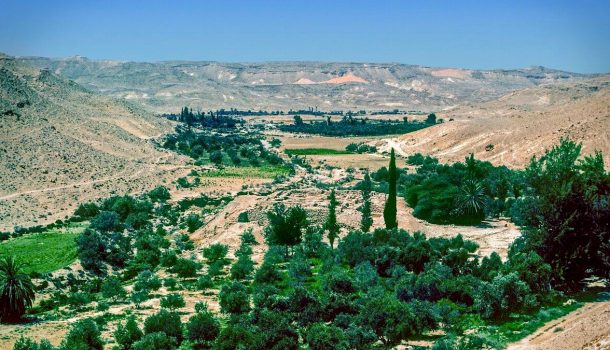 |
| generally accepted site of Kadesh Barnea, courtesy, TouchPointIsrael.com |
Several times, Kadesh Barnea is mentioned
in the Biblical texts: Genesis
14:7 "And they [Canaanite King Chedorlaomer of Elam
and his allies] turned back, and came to En-mishpat--the same is Kadesh [Petra?]--and smote all the country of
the Amalekites, and also the Amorites, that dwelt in Hazazon-tamar." From
Kadesh, Moses sent the Israelites to spy out the Land of Canaan. Only two came
back with positive reports. Numbers
13:26 "And they went and came to Moses, and to Aaron,
and to all the congregation of the children of Israel, unto the wilderness of
Paran, to Kadesh; and brought back word unto them, and unto all the
congregation, and showed them the fruit of the land." Numbers
20:1 "And the children of Israel, even the whole
congregation, came into the wilderness of Zin in the first month; and the
people abode in Kadesh; and Miriam died
there, and was buried there." At the site of Meribah which is in Kadesh, Moses disobediently struck the
rock that brought forth water (Numbers 20:11). Numbers
20:14-16 "And Moses sent messengers
from Kadesh unto the king of Edom…” According to Numbers 34:4, when the time
comes that the Israelites will take over Canaan, Kadesh Barnea was designated
as being the southwestern most site of the Land of Israel. Deuteronomy 9:23 “And when the Lord sent you
from Kadesh-barnea, saying, ‘Go up and take possession of the land that I have
given you,’ then you rebelled against the commandment of the Lord your God
and did not believe him or obey his voice.” Once the Israelites did take possession
of Canaan and divided it among the tribes, Kadesh Barnea was allotted to Judah,
becoming its westernmost point (Joshua 15:3).
For
centuries, since the beginning of the Roman occupation of Judea, the location
of Kadesh Barnea was a source of debate among scholars and later, archaeologists.
Recent scholars have maintained a two-site theory, with a western
Kadesh in the area of the Sinai Desert, and an eastern Kadesh centered around
Petra in, what is today, the southwest of Arab-occupied Jordan. This
two-site theory also appears to have been held by Josephus who identified Miriam's burial site (which the Bible
identifies as Kadesh) with Petra, and Eusebius of Caesarea an early church
father. This was also the opinion of Rabbis Abraham ibn Ezra (12th
century) and Moshe ben Nahman (13th century). In 1842, archeologists had concluded
that the site actually lies midway between Al-'Arish and Mount Hor in a great
treeless limestone plateau. The spring of clear water, which rises at the foot
of a limestone cliff, has been
called, by the Arabs "Ain-Ḳadis",
"spring of Kadesh".
By the late nineteenth century, as many as eighteen sites
had been proposed. One source of confusion has been the fact that Kadesh
is sometimes mentioned in connection with the Desert of Paran (Numbers 13:26)
and at other times with the Wilderness of Zin (Numbers 20:1).
Nowadays however, a
majority tend to agree that the site is the location of a group of springs
centered around a place called El
Godayrat Spring, in the near vicinity of Ain Kadis, about 46 miles southwest
of Beersheba, just over the border from Israel in the Arab-occupied Sinai. And in
fact, the Bible does locate Kadesh as south of Canaan, west of the Arabah and east of the Brook of Egypt. According to
Deuteronomy 1:2, it is 11 days' march by way of Mount Seir from Horeb. In the aftermath of the Sinai
Campaign of 1956, a large fortress from the period of the kings of
Judah was discovered Ain Kadis as well as numerous remains strewn throughout
the whole area from the Middle Bronze (c. 2000 b.c.e.) and Israelite periods.
In
modern times, Jews began to return to the area. Kadesh was liberated in the
Six-Day War in 1967 and in 1980, a Jewish community was established nearby – Nitzanei Sinai. But due to the peace
treaty with Egypt, in 1982, Prime Minister Menahem Begin ordered the Israeli
army, acting in the form of the SS, to destroy and expel the Jewish inhabitants
of the town, as they were ordered to do with the rest of the Sinai Peninsula.
In 1986, the whole of Nitzanei Sinai was relocated to the western Negev in an
area about midway between Eilat and Rafiah, almost adjacent to the Israel-Sinai
border.
No comments:
Post a Comment